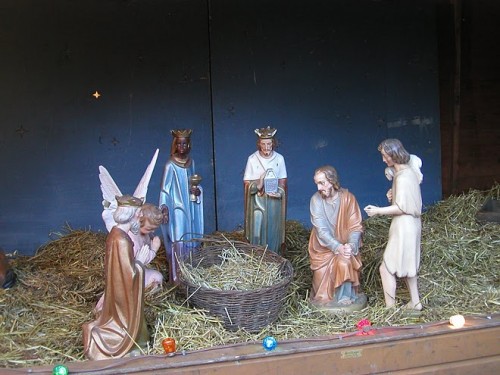 Typically we discuss how the mainstream media handles religious news. Occasionally we look at treatment of religion outside of news pages. A former GetReligion contributor alerted us to the New York Times house editorial for Christmas Day. It's short, but here's the first paragraph:
Typically we discuss how the mainstream media handles religious news. Occasionally we look at treatment of religion outside of news pages. A former GetReligion contributor alerted us to the New York Times house editorial for Christmas Day. It's short, but here's the first paragraph:
What are your Christmases made of? A tree full of ornaments as old as you are? A customary feast, if not of roast beast? Perhaps they're composed of wassail and yule, nog and Noel, Scrooge, "Scrooged," Pickwick and Charlie Brown. Or Handel and Berlioz, Garland, Cole, Crosby and Clooney, the Rockettes and the dance of a Sugar Plum Fairy, even Bedford Falls and "The Bishop's Wife." To Christians everywhere, Christmas comprises, above all, a decree from Caesar Augustus and in the same country shepherds abiding.
Quite lyrical prose, eh? But did you notice anything missing?
It really is impressive to write a Christmas editorial that steadfastly refuses to mention either the name of Jesus or the fact of his birth. And yet the remaining paragraphs – all beautifully written as well – fail to mention these things. Now, maybe the New York Times editorial page members know so few Christians that they actually believe that Christmas is – above all – mostly about a decree from Caesar Augustus and shepherds abiding. I don't know. I'm on record pooh-poohing the Christmas wars, but have things really gotten to the point where you can't mention Jesus' birth in a Christmas editorial?
Over at Commonweal, longtime religion writer Peter Steinfels comes to the paper's defense. He says that each department at the Times has its own culture, that it does many things that are egregious, but that it does many awesome things "entailing rare skills, unusual dedication, exhausting work, sacrifice of corporate profits, not infrequently even risk of life." He mentions the horrific "Vows" column in a recent Sunday Style Section:
But the Christmas editorial discussed below is something else. It is not the editorial I might have written had I ever been invited (or accepted) to join the editorial page. There are many Christmas editorials, including some redolent with explicit celebration of Christ's birth, that I might not have written. But they don't stir my ire or sense of victimization either. Here we have four paragraphs of admirable, if somewhat bland, Christmas-related sentiments. It could have been written, for all I know, by an editor who was at Midnight Mass. But he or she consciously wrote it from a religiously neutral standpoint, except perhaps for the final endorsement of "prayer." And it was written for a readership about whose religious convictions no assumptions could or would be made. This is, it seems to me, not the only possible but nonetheless a very plausible and respectful reflection of our contemporary pluralism. There really are many people who are not out to get us but who sincerely and thoughtfully don't believe in Christ or Christianity. Are we shocked, shocked, by that? I think we should get used to it.
So what do you think? Is it really offensive to say that to Christians, Christmas is about the birth of Jesus? How is that not "religiously neutral" since it's just a statement of fact? A brief editorial doesn't need a dissertation on the birth of Christ, of course. But how about a brief mention?
And isn't the biggest problem with the editorial the confusion about what – "above all" – Christmas is about for Christians? A decree and shepherds? Is it ignorant, silly or religiously neutral? One commenter wrote:
This is not a question of being "religiously neutral," but of political correctness carried to absurdity. Do you really think any religious or secular sensibilities would have been offended had the center of the Nativity triptych been mentioned? The image that comes to mind is of a painting with a Roman Emperor on the right and shepherds on the left – and a huge empty spot in the middle of the canvas.
Steinfels says that he thinks that, if anything, the editorial writer assumed too much religious literacy. The editorialist later references the "liturgical calendar" which supports Steinfels' view.
So what do you think? Was the piece just purposely "oblique and breezy," overly pluralistic or just fine?
